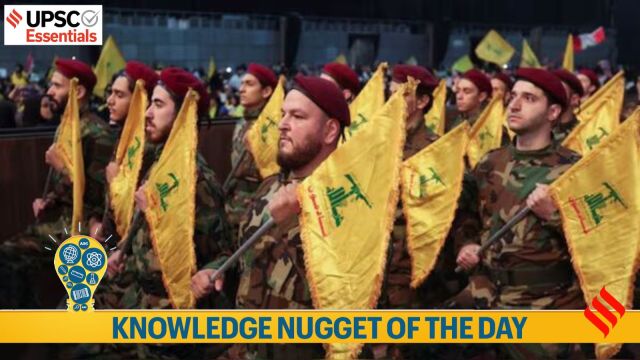
Knowledge Nugget: Hezbollah
Subject: International Relations
Why in news?
A major escalation in the year-long conflict in West Asia has emerged. Israel, after seemingly ending its military operation against Hamas in Gaza, has now turned its attention to the larger and more powerful Iranian proxy, Hezbollah, by launching a military operation in Lebanon. This comes after significant explosions targeted Hezbollah members using pagers and walkie-talkies, as well as the assassination of its long-time leader, Hassan Nasrallah.
Key Takeaways :
1. Hezbollah translates to “Party of God”. The think tank Centre for Strategic and International Studies (CSIS) has previously described it as “The world’s most heavily armed non-state actor, with a large and diverse stockpile of unguided artillery rockets, as well as ballistic, antiair, antitank, and antiship missiles.”
2. Hezbollah originated during the Lebanese Civil War (1975-1990), which was a result of “long-simmering discontent over the large, armed Palestinian presence in the country”, according to the Council on Foreign Relations (CFR).
3. Lebanon borders Israel to its north. Amid its internal ethnic and religious divisions, the arrival of Palestinian refugees from 1948 onwards — after the creation of Israel as a state for Jewish people that year — led to added tensions. Israeli forces invaded southern Lebanon in 1978 and again in 1982 to expel Palestinian guerrilla fighters.
4. Hezbollah was formed around this time, inspired by the formation of a theocratic Islamic government in Iran in 1979. Iran and its Islamic Revolutionary Guard Corps (IRGC) also provided funding to the group.
Story continues below this ad
5. Hezbollah opposes Israel and Western influence in the Middle East. Hezbollah’s positioning also reflects West Asia’s two major powers and their rivalry – the Sunni Muslim-dominated Saudi Arabia and the majority Shia Muslim-dominated Iran.
JUST FYI: On Tuesday, Israeli troops invaded Lebanon calling it a “limited, localised and targeted” ground operation against the Iran-backed militia. Hezbollah has vowed to continue firing rockets into Israel until there is a cease-fire in Gaza with Hamas, which Iran also supports.
BEYOND THE NUGGET: Houthis, India-Middle East-Europe Economic Corridor (IMEC)
Houthis
6. The Houthis are a large clan belonging to the Zaidi Shia sect, with roots in Yemen’s northwestern Saada province. Zaidis make up around 35 per cent of Yemen’s population.
Story continues below this ad
7. The Zaidis ruled over Yemen for over a thousand years until 1962, when they were overthrown and a civil war followed, which lasted until 1970. The Houthi clan began to revive the Zaidi tradition from the 1980s, resisting the increasing influence of the Salafists, who were funded by the state.
8. Iran, a Shia-majority country, is believed to back the Houthis, even as it has denied the charge. Its regional rival, the Sunni-majority Saudia Arabia (along with Western allies like the US) backs the Yemen government. Houthis’ support for Palestine is, therefore, also a manifestation of existing regional rivalries.
IMEC
9. The widening conflict in West Asia could jeopardise the progress of the India-Middle East-Europe Economic Corridor (IMEC), which was announced last year during the G20 meeting in New Delhi.
Story continues below this ad
10. IMEC is a connectivity project that seeks to develop a seamless infrastructure of ports, railways, roads, sea lines and pipelines to enhance trade among India, the Arabian Peninsula, the Mediterranean region and Europe.
11. India has three broad reasons for joining the IMEC.
(i) Firstly, it builds on the existing trade and economic relations between India and the Arab Gulf region, which has the potential to grow further if the necessary infrastructure and connectivity gaps are filled, and the IMEC precisely intends to do that. Thus, the IMEC supplements the existing goal of developing Indo-Gulf economic relations.
(ii) Secondly, the IMEC does not end in the Middle East. It promises to connect India with the Eastern Mediterranean and Western Europe with a shorter route bypassing the naval choke points of Bab al-Mandab and the Suez Canal. The mega offshore gas fields in the Eastern Mediterranean are an additional attraction as India’s appetite for energy and gas will continue to grow.
(iii) Thirdly, there is geopolitical logic for India as far as the IMEC is concerned. India is the world’s largest democracy and has carved a path for economic growth since embarking on liberalisation in 1991. As a major G-20 economy with a large youth population, it aspires to emerge as a global power. With greater integration with its eastern and western neighbourhoods and the larger world, the big power aspiration can be realised.
Story continues below this ad
(Source: Hezbollah and its military capabilities, Israel-Iran conflict heightens risk, IMEC: Significance and Prospects for India)
For your queries and suggestions write at roshni.yadav@indianexpress.com
Subscribe to our UPSC newsletter and stay updated with the news cues from the past week.
Stay updated with the latest UPSC articles by joining our Telegram channel – Indian Express UPSC Hub, and follow us on Instagram and X.


































